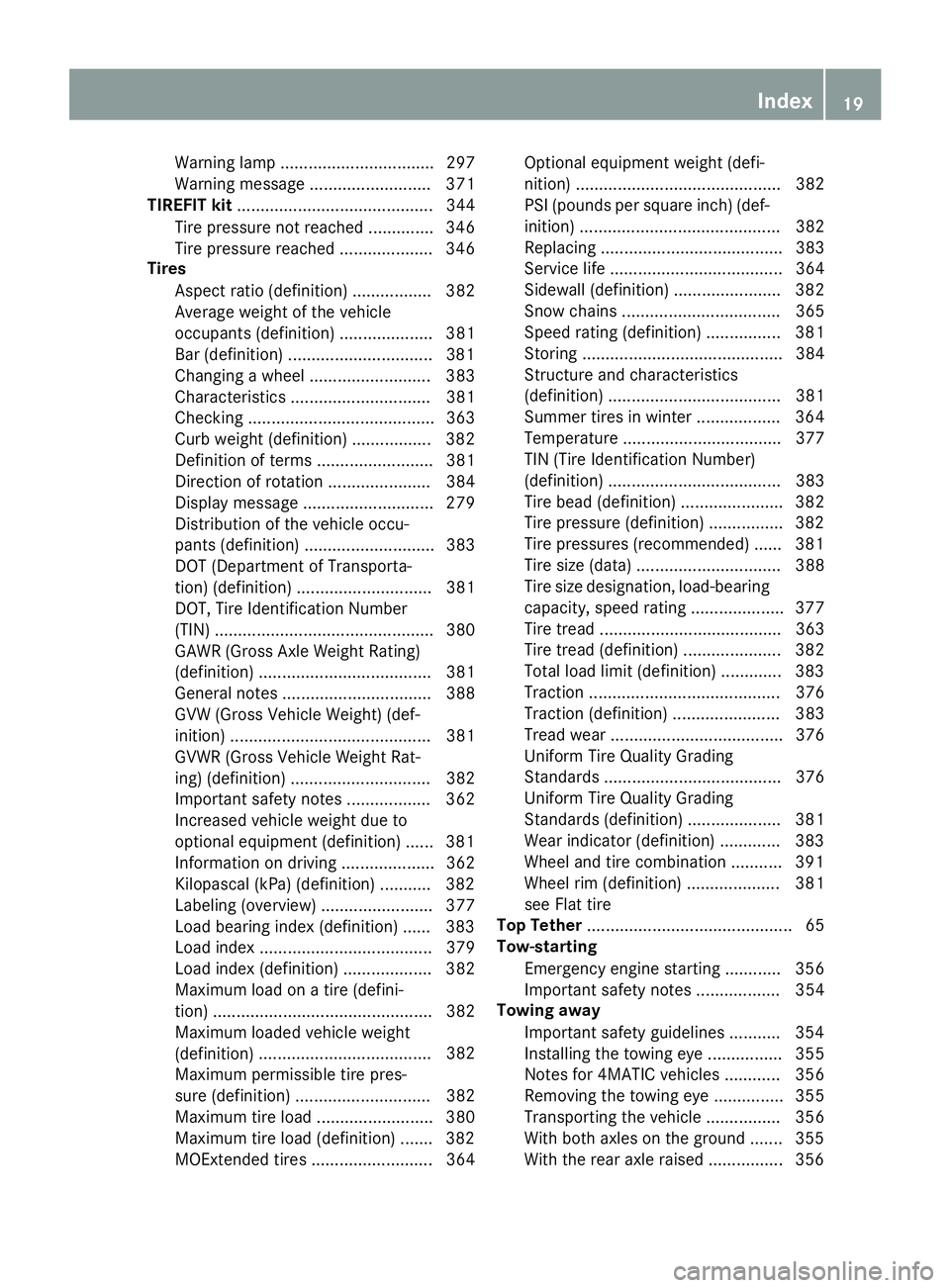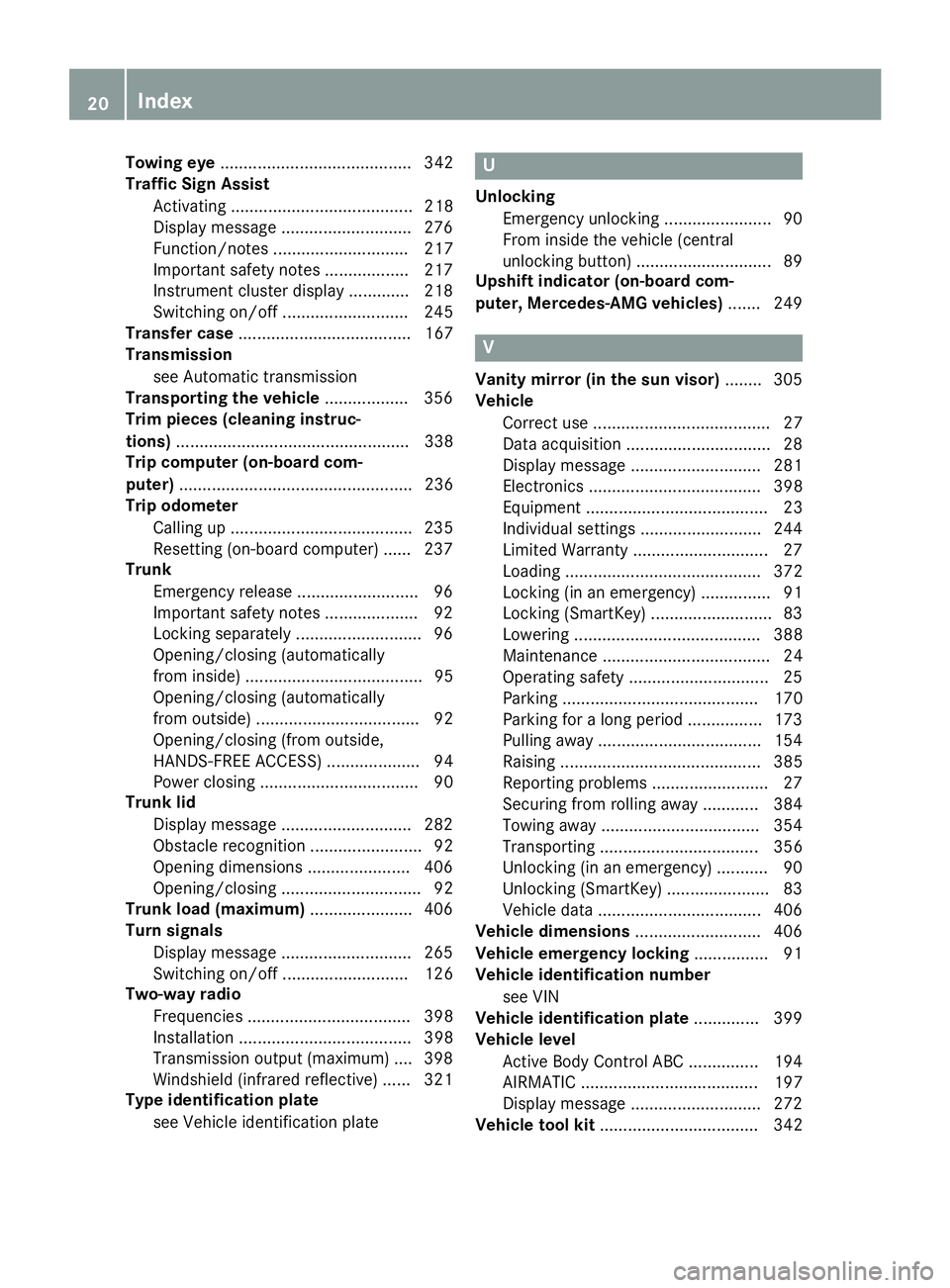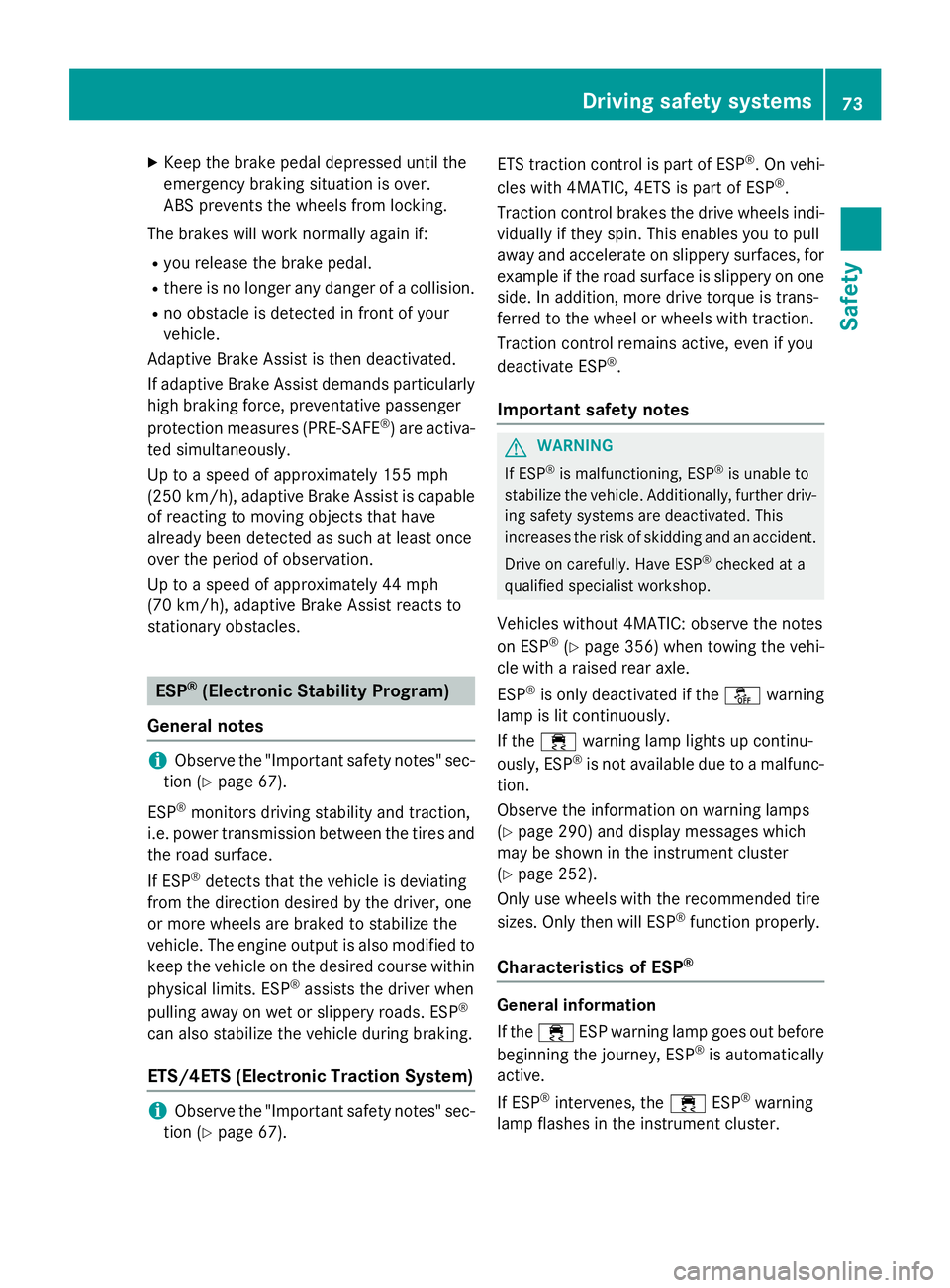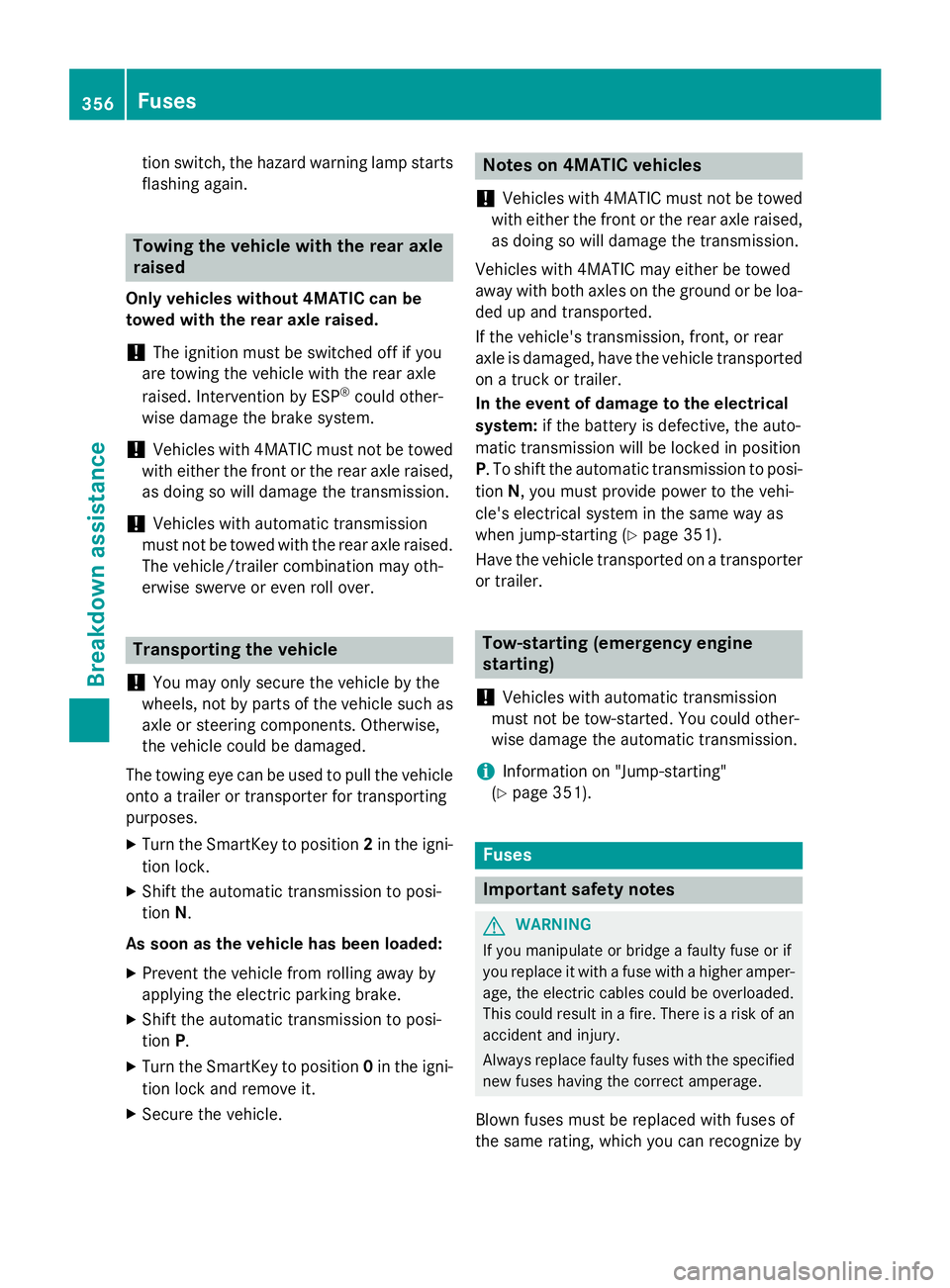2016 MERCEDES-BENZ S-COUPE emergency towing
[x] Cancel search: emergency towingPage 21 of 410

Warning lamp ................................. 297
Warning message .......................... 371
TIREFIT kit .......................................... 344
Tire pressure not reached .............. 346
Tire pressure reached .................... 346
Tires
Aspect ratio (definition) ................. 382
Average weight of the vehicle
occupants (definition) .................... 381
Bar (definition) ...............................3 81
Changing a wheel .......................... 383
Characteristics .............................. 381
Checking ........................................ 363
Curb weight (definition) ................. 382
Definition of terms ......................... 381
Direction of rotation ...................... 384
Display message ............................ 279
Distribution of the vehicle occu-
pants (definition) ............................ 383
DOT (Department of Transporta-
tion) (definition) ............................. 381
DOT, Tire Identification Number
(TIN) ............................................... 380
GAWR (Gross Axle Weight Rating)
(definition) ..................................... 381
General notes ................................ 388
GVW (Gross Vehicle Weight) (def-
inition) ........................................... 381
GVWR (Gross Vehicle Weight Rat-
ing) (definition) .............................. 382
Important safety notes .................. 362
Increased vehicle weight due to
optional equipment (definition) ...... 381
Information on driving .................... 362
Kilopascal (kPa) (definition) ........... 382
Labeling (overview) ........................ 377
Load bearing index (definition) ...... 383
Load index ..................................... 379
Load index (definition) ................... 382
Maximum load on a tire (defini-
tion) ............................................... 382
Maximum loaded vehicle weight
(definition) ..................................... 382
Ma
ximum permissible tire pres-
sure (definition) ............................. 382
Maximum tire load ......................... 380
Maximum tire load (definition) ....... 382
MOExtended tires .......................... 364 Optional equipment weight (defi-
nition) ............................................ 382
PSI (pounds per square inch) (def-
inition) ........................................... 382
Replacing ....................................... 383
Service life ..................................... 364
Sidewall (definition) ....................... 382
Snow chains .................................. 365
Speed rating (definition) ................ 381
Storing ........................................... 384
Structure and characteristics
(definition) ..................................... 381
Summer tires in winter .................. 364
Temperature .................................. 377
TIN (Tire Identification Number)
(definition) ..................................... 383
Tire bead (definition) ...................... 382
Tire pressure (definition) ................ 382
Tire pressures (recommended) ...... 381
Tire size (data) ............................... 388
Tire size designation, load-bearing
capacity, speed rating .................... 377
Tire tread ....................................... 363
Tire tread (definition) ..................... 382
Total load limit (definition) ............. 383
Traction ......................................... 376
Traction (definition) ....................... 383
Tread wear ..................................... 376
Uniform Tire Quality Grading
Standards ...................................... 376
Uniform Tire Quality Grading
Standards (definition) .................... 381
Wear indicator (definition) ............. 383
Wheel and tire combination ........... 391
Wheel rim (definition) .................... 381
see Flat tire
Top Tether ............................................ 65
Tow-starting
Emergency engine starting ............ 356
Important safety notes .................. 354
Towing away
Important safety guidelines ........... 354
Installing the towing eye ................ 355
Notes for 4MATIC vehicl es ............ 356
R
emoving the towing eye ............... 355
Transporting the vehicle ................ 356
With both axles on the ground ....... 355
With the rear axle raised ................ 356
Index19
Page 22 of 410

Towing eye......................................... 342
Traffic Sign Assist
Activating ....................................... 218
Display message ............................ 276
Function/notes ............................. 217
Important safety notes .................. 217
Instrument cluster display ............. 218
Switching on/off ........................... 245
Transfer case ..................................... 167
Transmission
see Automatic transmission
Transporting the vehicle .................. 356
Trim pieces (cleaning instruc-
tions) .................................................. 338
Trip computer (on-board com-
puter) .................................................. 236
Trip odometer
Calling up ....................................... 235
Resetting (on-board computer) ...... 237
Trunk
Emergency release .......................... 96
Important safety notes .................... 92
Locking separately ........................... 96
Opening/closing (automatically
from inside) ...................................... 95
Opening/closing (automatically
from outside) ................................... 92
Opening/closing (from outside,
HANDS-FREE ACCESS) .................... 94
Power closing .................................. 90
Trunk lid
Display message ............................ 282
Obstacle recognition ........................ 92
Opening dimensions ...................... 406
Opening/closing .............................. 92
Trunk load (maximum) ...................... 406
Turn signals
Display message ............................ 265
Switching on/off ........................... 126
Two-way radio
Frequencies ................................... 398
Installation ..................................... 398
Transmission output (maximum) .... 398
Windshield (infrared reflective) ...... 321
Type identification plate
see Vehicle identification plateU
UnlockingEmergency unlocking ....................... 90
From inside the vehicle (central
unlocking button) ............................. 89
Upshift indicator (on-board com-
puter, Mercedes-AMG vehicles) ....... 249
V
Vanity mirror (in the sun visor)........ 305
Vehicle
Correct use ...................................... 27
Data acquisition ............................... 28
Display message ............................ 281
Electronics ..................................... 398
Equipment ....................................... 23
Individual settings .......................... 244
Limited Warranty ............................. 27
Loading .......................................... 372
Locking (in an emergency) ............... 91
Locking (SmartKey) .......................... 83
Lowering ........................................ 388
Maintenance .................................... 24
Operating safety .............................. 25
Parking .......................................... 170
Parking for a long period ................ 173
Pulling away ................................... 154
Raising ........................................... 385
Reporting problems ......................... 27
Securing from rolling away ............ 384
Towing away .................................. 354
Transporting .................................. 356
Unlocking (in an emergency) ........... 90
Unlocking (SmartKey) ...................... 83
Vehicle data ................................... 406
Vehicle dimensions ........................... 406
Vehicle emergency locking ................ 91
Vehicle identification number
see VIN
Vehicle identification plate .............. 399
Vehicle level
Active Body Control ABC ............... 194
AIRMATIC ...................................... 197
Display message ............................ 272
Vehicle tool kit .................................. 342
20Index
Page 75 of 410

XKeep the brake pedal depressed until the
emergency braking situation is over.
ABS prevents the wheels from locking.
The brakes will work normally again if:
Ryou release the brake pedal.
Rthere is no longer any danger of a collision.
Rno obstacle is detected in front of your
vehicle.
Adaptive Brake Assist is then deactivated.
If adaptive Brake Assist demands particularly
high braking force, preventative passenger
protection measures (PRE-SAFE
®) are activa-
ted simultaneously.
Up to a speed of approximately 155 mph
(250 km/h), adaptive Brake Assist is capable
of reacting to moving objects that have
already been detected as such at least once
over the period of observation.
Up to a speed of approximately 44 mph
(70 km/h), adaptive Brake Assist reacts to
stationary obstacles.
ESP®(Electronic Stability Program)
General notes
iObserve the "Important safety notes" sec-
tion (
Ypage 67).
ESP
®monitors driving stability and traction,
i.e. power transmission between the tires and
the road surface.
If ESP
®detects that the vehicle is deviating
from the direction desired by the driver, one
or more wheels are braked to stabilize the
vehicle. The engine output is also modified to
keep the vehicle on the desired course within
physical limits. ESP
®assists the driver when
pulling away on wet or slippery roads. ESP®
can also stabilize the vehicle during braking.
ETS/4ETS (Electronic Traction System)
iObserve the "Important safety notes" sec-
tion (
Ypage 67). ETS traction control is part of ESP
®. On vehi-
cles with 4MATIC, 4ETS is part of ESP®.
Traction control brakes the drive wheels indi-
vidually if they spin. This enables you to pull
away and accelerate on slippery surfaces, for
example if the road surface is slippery on one
side. In addition, more drive torque is trans-
ferred to the wheel or wheels with traction.
Traction control remains active, even if you
deactivate ESP
®.
Important safety notes
GWARNING
If ESP
®is malfunctioning, ESP®is unable to
stabilize the vehicle. Additionally, further driv-
ing safety systems are deactivated. This
increases the risk of skidding and an accident.
Drive on carefully. Have ESP
®checked at a
qualified specialist workshop.
Vehicles without 4MATIC: observe the notes
on ESP®(Ypage 356) when towing the vehi-
cle with a raised rear axle.
ESP
®is only deactivated if the åwarning
lamp is lit continuously.
If the ÷ warning lamp lights up continu-
ously, ESP
®is not available due to a malfunc-
tion.
Observe the information on warning lamps
(
Ypage 290) and display messages which
may be shown in the instrument cluster
(
Ypage 252).
Only use wheels with the recommended tire
sizes. Only then will ESP
®function properly.
Characteristics of ESP®
General information
If the ÷ ESP warning lamp goes out before
beginning the journey, ESP
®is automatically
active.
If ESP
®intervenes, the ÷ESP®warning
lamp flashes in the instrument cluster.
Driving safety systems73
Safety
Z
Page 358 of 410

tion switch, the hazard warning lamp starts
flashing again.
Towing the vehicle with the rear axle
raised
Only vehicles without 4MATIC can be
towed with the rear axle raised.
!The ignition must be switched off if you
are towing the vehicle with the rear axle
raised. Intervention by ESP
®could other-
wise damage the brake system.
!Vehicles with 4MATIC must not be towed
with either the front or the rear axle raised,
as doing so will damage the transmission.
!Vehicles with automatic transmission
must not be towed with the rear axle raised.
The vehicle/trailer combination may oth-
erwise swerve or even roll over.
Transporting the vehicle
!
You may only secure the vehicle by the
wheels, not by parts of the vehicle such as axle or steering components. Otherwise,
the vehicle could be damaged.
The towing eye can be used to pull the vehicle
onto a trailer or transporter for transporting
purposes.
XTurn the SmartKey to position 2in the igni-
tion lock.
XShift the automatic transmission to posi-
tion N.
As soon as the vehicle has been loaded:
XPrevent the vehicle from rolling away by
applying the electric parking brake.
XShift the automatic transmission to posi-
tion P.
XTurn the SmartKey to position 0in the igni-
tion lock and remove it.
XSecure the vehicle.
Notes on 4MATIC vehicles
!
Vehicles with 4MATIC must not be towed
with either the front or the rear axle raised,
as doing so will damage the transmission.
Vehicles with 4MATIC may either be towed
away with both axles on the ground or be loa- ded up and transported.
If the vehicle's transmission, front, or rear
axle is damaged, have the vehicle transported
on a truck or trailer.
In the event of damage to the electrical
system: if the battery is defective, the auto-
matic transmission will be locked in position
P . To shift the automatic transmission to posi-
tion N, you must provide power to the vehi-
cle's electrical system in the same way as
when jump-starting (
Ypage 351).
Have the vehicle transported on a transporter
or trailer.
Tow-starting (emergency engine
starting)
!
Vehicles with automatic transmission
must not be tow-started. You could other-
wise damage the automatic transmission.
iInformation on "Jump-starting"
(
Ypage 351).
Fuses
Important safety notes
GWARNING
If you manipulate or bridge a faulty fuse or if
you replace it with a fuse with a higher amper- age, the electric cables could be overloaded.
This could result in a fire. There is a risk of an
accident and injury.
Always replace faulty fuses with the specified
new fuses having the correct amperage.
Blown fuses must be replaced with fuses of
the same rating, which you can recognize by
356Fuses
Breakdown assistance